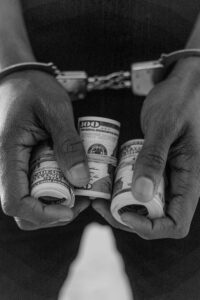
When asked by a curious reporter why he kept robbing banks, “Slick Willie” Sutton responded curtly: “because that’s where the money is.”
Robbery, the act of entering an open bank and extracting money by force or threat of force, is distinct from burglary, which constitutes breaking into a closed bank.
The first notable period of bank robbery in American history coincides with the country’s expansion westward. Roaming gangs of outlaws like Butch Cassidy’s Wild Bunch and the James-Younger Gang swept across the fabled, lawless Wild West, robbing banks, holding up trains, and killing law-enforcement officers. Historians believe the first bank robbery in the United States occurred when associates of Jesse and Frank James robbed the Clay County Savings Association in Liberty, Missouri on February 13, 1866. The bank was owned by former Republican militiamen and the James brothers and their associates were staunch and bitter ex-Confederates. The gang escaped with $60,000 and wounded an innocent bystander in the getaway process. Soon after, the James brothers joined forces with outlaw Cole Younger and a few other former Confederates to form the James-Younger Gang. They traveled across the southern and western United States, choosing to rob banks and stagecoaches often in front of large crowds of people. They became larger-than-life anti-heroes of the West and the old Confederacy. The Wild Bunch, operating in the early 1900s and featuring Butch Cassidy, the Sundance Kid, and Ben Kilpatrick, was another iconic outlaw gang of the Wild West. While they primarily robbed trains, The Wild Bunch was responsible for several bank robberies including one at the First Nation Bank in Winnemucca, Nevada for over $32,000.
As increasing numbers of people settled and developed the West, the era of the bank-robbing outlaw waned, only to be replaced by the “Public Enemy” era of the 1930s. The increase in bank robberies and organized crime during the 1920s and 1930s forced J. Edgar Hoover to develop an enhanced Federal Bureau of Investigation (FBI). He appropriated the term “public enemy” as a publicity stunt referring to wanted criminals already charged with crimes. Hoover passed down the dubious distinction of being “Public Enemy No. 1″ to outlaws John Dillinger, Pretty Boy Floyd, Baby Face Nelson, and Alvin “Creepy” Karpis respectively, as each were either killed or arrested. Set against the backdrop of the Great Depression, the bank robberies of each “public enemy” loomed large and glamorous. Nearly forgotten today, Harvey John Bailey, whose bank robbing between 1920 and 1933 netted him over $1 million, was called “The Dean of American Bank Robbers.” John Dillinger and his associated gang robbed dozens of banks between 1933 and 1934 and may have accumulated over $300,000. While Dillinger occupied an almost Robin Hood-like place in American culture, his partner, Baby Face Nelson, was the antithesis. Nelson was notorious for shooting both lawmen and innocent bystanders, and holds the record for killing more FBI agents in the line of duty than any other criminal. The success of these “public enemies” was short lived; in 1934 the FBI trapped and killed Dillinger, Nelson, and Floyd.
While bank robberies remained common in the early 1900s with perpetrators like Bonnie & Clyde, the evolution of anti-robbery technology has made it much more difficult to rob a bank and get away with it in the modern era. Exploding dye packs, security cameras, and silent alarms have all contributed to the drop in successful bank robberies. Although the heyday of the American bank robber is behind us, the crime continues to be attempted by many who are looking for easy money.
Back to Crime Library
|
|
|
